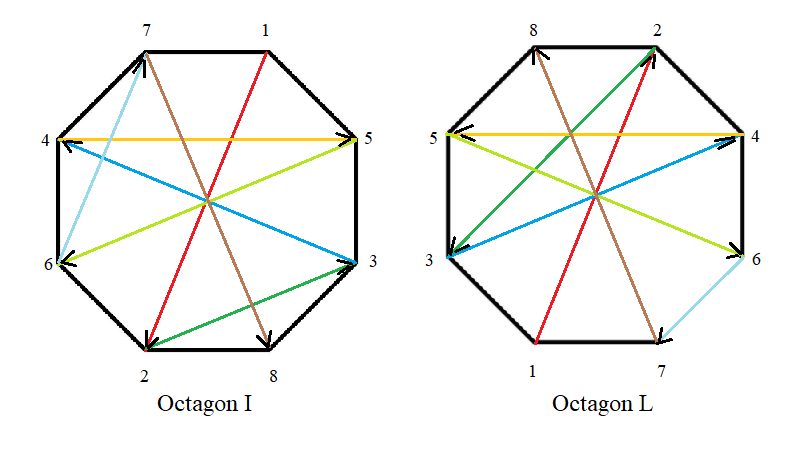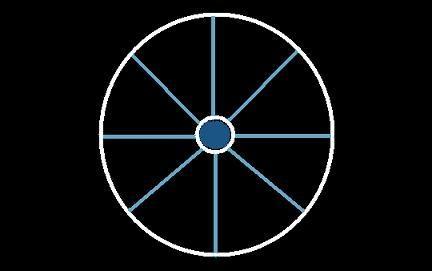Octagon Algorithm for Border Wheel Squares (Part XIII)
The Eight Node Way - (1,4,7) Squares
The previous section Part XII looked at (a,d,f) type squares specifically the 9×9 squares where the initial, central cell number was one and the Octagon I and L algorithms were used for filling in the non spoke cells. Part XIII will continue with 9×9 squares where the intial numbers will now be 3, 5, 7, 9, 11 or 13 in order to cover all the possible wheel structures.
In addition, we have to decide what consecutive three numbers to place into the 3×3 internal square so that each row, column and diagonal sums to 123. The triplet of numbers (22,23,24) to (34,35,36) in Table Ib fit the description since they will be shown not to be present as numbers in the other spoke cells. Thus, these triplets will have the requisite properties, since the rest of the even triplets will have at least one number in common with a number in every spoke of the wheel. The triplet (22,23,24) has already being used in Part XII where the initial number in the top central cell is one. This section, therefore, will cover only the triplets starting at (24,25,26) to (34,35,36) since (22,23,24) cannot be employed with the new wheel structures:
Table Ia
| Even c |
| 2,3,4 |
| 4,5,6 |
| 6,7,8 |
| 8,9,10 |
| 10,11,12 |
| 12,13,14 |
| 14,15,16 |
| 16,17,18 |
| 18,19,20 |
|
| |
Table Ib
| Even c |
| 20,21,22 |
| 22,23,24 |
| 24,25,26 |
| 26,27,28 |
| 28,29,30 |
| 30,31,32 |
| 32,33,34 |
| 34,35,36 |
| 36,37,38 |
|
|
The Other Six 9×9 Wheel Structures
This section will deal with numbers (after the main diagonal is filled) that run in the order a (top center), d (bottom right) and f (left center) where (a,d,f) vary in increments of two from (3,6,9), (5,8,11) ... to (13,16,19). A difference (Δ) of 7 is then added to each of the (a,d,f) numbers followed by taking a triplet from Table Ib that has no common number in the spokes. The wheel portion of the square is filled according to Part X, using the blue color values from Table Ib to ensure that every row, column and diagonal of the internal 3×3 square adds up to the magic sum of 123. The construction of the square is then completed by the use the I and L algorithms, using graph theory, as was done previously in Part X.

In Part XII we were able to construct 7 wheel structures, starting with an initial number 1 in the top center cell. In this section the next initial numbers to be constructed are those that are two units apart such as the six odd numbers (3-13) listed above. Squares 9b thru 9g carry on this tradition using the new odd numbers. Using Table Ib a triplet is chosen for the internal 3×3 squares as shown below. A legal triplet is one whose numbers do not match a number in one of the spokes of the wheel. For instance, the triplet (22,23,24) is not usable in 9b since the number 23 is already a term in the middle row. Moreover, the triplet in the caption is the one being used to generate square 9b.
And the same can be said for the other 5 squares. In addition, from Table Ib if we count the number of triplets that can be used by a square, we find that 9b can use 6 triplets (in blue), 9c 5 triplets, 9d 4 triplets ... and so on until only one triplet is left over for 9g. Thus, for every square the number of triplets follows the order 6 for b, 5 for c, 4 for d, 3 for e, 2 for g and 1 for f plus the original 7 triplets for Square 9 from Part XII. Altogether then the sum of all these 9×9 consecutive squares that can be constructed is 28. However, since the numbers in the white cells are interchangeable many more squares are possible. For example, there are six ways where the blue/green colors in row one may be placed, while keeping the wheel construct the same.
So when all is said and done the non spoke portions of the squares are filled in according to the Octagon I algorithm for the blue color cells and the L algorithm for the green color cells. Below are shown six of the 9×9 squares not counting the 9a(22,23,24)il in Part XII:
Border 9b(24,25,26)il
| 76 | 80 | 74 |
68 | 3 |
15 | 7 |
1 | 45 |
| 5 | 69 | 60 |
53 | 10 | 30 |
21 |
44 | 77 |
| 12 | 28 | 62 |
49 | 17 |
34 | 43 | 54 |
70 |
| 63 | 50 | 46 |
57 | 24 |
42 | 36 | 32 | 19 |
| 9 | 16 |
23 | 26 |
41 | 56 |
59 | 66 |
73 |
| 18 | 31 | 35 |
40 | 58 |
25 | 47 | 51 | 64 |
| 71 | 55 | 39 |
33 | 65 |
48 | 20 | 27 | 11 |
| 78 | 38 | 22 |
29 | 72 | 52 |
61 | 13 | 4 |
| 37 | 2 | 8 |
14 | 79 |
67 | 75 | 81 | 6 |
|
|
Border 9c(26,27,28)il
| 74 | 80 | 75 |
69 | 5 |
14 | 6 |
1 | 45 |
| 4 | 67 | 61 |
53 | 12 | 30 |
20 |
44 | 78 |
| 10 | 24 | 60 |
49 | 19 |
34 | 43 | 58 |
72 |
| 65 | 50 | 46 |
55 | 26 |
42 | 36 | 32 | 17 |
| 11 | 18 |
25 | 28 |
41 | 54 |
57 | 64 |
71 |
| 16 | 31 | 35 |
40 | 56 |
27 | 47 | 51 | 66 |
| 73 | 59 | 39 |
33 | 63 |
48 | 22 | 23 | 9 |
| 79 | 38 | 21 |
29 | 70 | 52 |
62 | 15 | 3 |
| 37 | 2 | 7 |
13 | 77 |
68 | 76 | 81 | 8 |
|
Border 9d(28,29,30)il
| 72 | 80 | 76 |
71 | 7 |
12 | 5 |
1 | 45 |
| 4 | 65 | 63 |
57 | 14 | 26 |
18 |
44 | 78 |
| 9 | 23 | 58 |
49 | 21 |
34 | 43 | 59 |
73 |
| 66 | 50 | 46 |
53 | 28 |
42 | 36 | 32 | 16 |
| 13 | 20 |
27 | 30 |
41 | 52 |
55 | 62 |
69 |
| 15 | 31 | 35 |
40 | 54 |
29 | 47 | 51 | 67 |
| 74 | 60 | 39 |
33 | 61 |
48 | 24 | 22 | 8 |
| 79 | 38 | 19 |
25 | 68 | 56 |
64 | 17 | 3 |
| 37 | 2 | 6 |
11 | 75 |
70 | 77 | 81 | 10 |
|
|
Border 9e(30,31,32)il
| 70 | 80 | 76 |
72 | 9 |
11 | 5 |
1 | 45 |
| 4 | 63 | 64 |
58 | 16 | 25 |
17 |
44 | 78 |
| 8 | 21 | 56 |
49 | 23 |
34 | 43 | 61 |
74 |
| 68 | 54 | 46 |
51 | 30 |
42 | 36 | 28 | 14 |
| 15 | 22 |
29 | 32 |
41 | 50 |
53 | 60 |
67 |
| 13 | 27 | 35 |
40 | 52 |
31 | 47 | 55 | 69 |
| 75 | 62 | 39 |
33 | 59 |
48 | 26 | 20 | 7 |
| 79 | 38 | 18 |
24 | 66 | 57 |
65 | 19 | 3 |
| 37 | 2 | 6 |
10 | 73 |
71 | 77 | 81 | 12 |
|
Border 9f(32,33,34)il
| 68 | 80 | 76 |
73 | 11 |
10 | 5 |
1 | 45 |
| 4 | 61 | 66 |
60 | 18 | 23 |
15 |
44 | 78 |
| 8 | 20 | 54 |
53 | 25 |
30 | 43 | 62 |
74 |
| 69 | 55 | 46 |
49 | 32 |
42 | 36 | 27 | 13 |
| 17 | 24 |
31 | 34 |
41 | 48 |
51 | 58 |
65 |
| 12 | 26 | 35 |
40 | 50 |
33 | 47 | 56 | 70 |
| 75 | 63 | 39 |
29 | 57 |
52 | 28 | 19 | 7 |
| 79 | 38 | 16 |
22 | 64 | 59 |
67 | 21 | 3 |
| 37 | 2 | 6 |
9 | 71 |
72 | 77 | 81 | 14 |
|
|
Border 9g(34,35,36)il
| 66 | 80 | 76 |
73 | 13 |
10 | 5 |
1 | 45 |
| 4 | 59 | 67 |
61 | 20 | 22 |
14 |
44 | 78 |
| 8 | 18 | 52 |
54 | 27 |
29 | 43 | 64 |
74 |
| 70 | 57 | 50 |
47 | 34 |
42 | 32 | 25 | 12 |
| 19 | 26 |
33 | 36 |
41 | 46 |
49 | 56 |
63 |
| 11 | 24 | 31 |
40 | 48 |
35 | 51 | 58 | 71 |
| 75 | 65 | 39 |
28 | 55 |
53 | 30 | 17 | 7 |
| 79 | 38 | 15 |
21 | 62 | 60 |
68 | 23 | 3 |
| 37 | 2 | 6 |
9 | 69 |
72 | 77 | 81 | 16 |
|
This completes the Octagon I and L method. Go to Part XIV
Go back to Part XII. Go back to homepage.
Copyright © 2022 by Eddie N Gutierrez. E-Mail: enaguti1949@gmail.com


